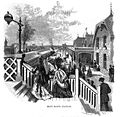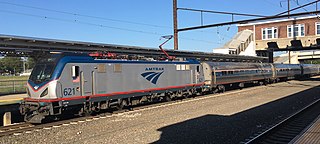
The Keystone Service is a 195 mile regional passenger train service from Amtrak between the Harrisburg Transportation Center in Harrisburg, Pennsylvania, and 30th Street Station in Philadelphia, running along the Philadelphia to Harrisburg Main Line. Most trains continue along the Northeast Corridor (NEC) to Penn Station in New York City.

The SEPTA Regional Rail system is a commuter rail network owned by SEPTA and serving the Philadelphia metropolitan area. The system has 13 branches and more than 150 active stations in Philadelphia, Pennsylvania, its suburbs and satellite towns and cities. It is the sixth-busiest commuter railroad in the United States, and the busiest outside of the New York, Chicago, and Boston metropolitan areas. In 2016, the Regional Rail system had an average of 132,000 daily riders and 118,800 daily riders as of 2019.

The Keystone Corridor is a 349-mile (562 km) railroad corridor between Philadelphia and Pittsburgh, Pennsylvania, that consists of two rail lines: Amtrak and SEPTA's Philadelphia-to-Harrisburg main line, which hosts SEPTA's Paoli/Thorndale Line commuter rail service, and Amtrak's Keystone Service and Pennsylvanian inter-city trains; and the Norfolk Southern Pittsburgh Line. The corridor was originally the Main Line of the Pennsylvania Railroad.

Overbrook station is a SEPTA Regional Rail station on the Paoli/Thorndale Line, located near 63rd Street and City Line Avenue in the Overbrook neighborhood of Philadelphia, Pennsylvania. It serves many of the residents of Overbrook Farms and the suburban neighborhoods across City Avenue in neighboring Montgomery County, as well as Saint Joseph's University and Talmudical Yeshiva of Philadelphia. Overbrook has two low-level side platforms with pathways connecting the platforms to the inner tracks.

Merion station is a SEPTA Regional Rail station on the Paoli/Thorndale Line, located in Merion, Pennsylvania just outside of Philadelphia. Merion has two low-level side platforms with pathways connecting the platforms to the inner tracks.

Ardmore station is a train station in Ardmore, Pennsylvania, located on the Pennsylvania Main Line. The station serves several Amtrak Keystone Service trains daily, as well as all SEPTA Paoli/Thorndale Line local regional rail trains. The station is 8.5 miles (13.7 km) from Suburban Station in Center City Philadelphia, and travel time to Suburban Station is 22 minutes on SEPTA local trains.

Haverford station is a SEPTA Regional Rail station in Haverford, Pennsylvania. It is served by most Paoli/Thorndale Line trains with the exception of a few express runs, and is located on Haverford Station Road. The station was originally built by the Pennsylvania Railroad.

Rosemont station is a SEPTA Regional Rail station in Rosemont, Pennsylvania. It is located at Airdale Road and Montrose Avenues and is served by most Paoli/Thorndale Line trains.

Villanova station is a SEPTA Regional Rail station on the campus of Villanova University in Villanova, Pennsylvania. It is in Radnor Township, located on North Spring Mill Road near County Line Road and serves most Paoli/Thorndale Line trains.

Radnor station is a SEPTA Regional Rail station in Radnor, Pennsylvania. It is served by most Paoli/Thorndale Line trains. Radnor has two low-level side platforms with pathways connecting the platforms to the inner tracks.

Strafford station is a commuter rail station located in the western suburbs of Philadelphia at Old Eagle School Road and Crestline Road, in Tredyffrin Township, and it is served by most Paoli/Thorndale Line trains.

Daylesford station is a commuter rail station located in the western suburbs of Philadelphia at Glenn Avenue and Lancaster Avenue in Berwyn, Pennsylvania. It is served by most Paoli/Thorndale Line trains.

Paoli station is a passenger rail station located in the western suburbs of Philadelphia at 13 Lancaster Avenue, Paoli, Pennsylvania. It is served by Amtrak's Keystone Service and Pennsylvanian trains, and most SEPTA Paoli/Thorndale Line trains.

Malvern station is a SEPTA Regional Rail and a former Amtrak station in Malvern, Pennsylvania. Located at West King Road and North Warren Avenue, it serves most Paoli/Thorndale Line trains. Until 1998, some Keystone Service trains stopped here as well.

Exton station is a train station in Exton, West Whiteland Township, Pennsylvania, in the western suburbs of Philadelphia. It is served by most Amtrak Keystone Service trains and one daily eastbound Pennsylvanian trip, as well as SEPTA's Paoli/Thorndale Line.
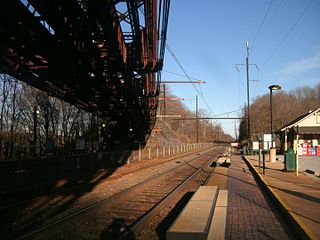
Whitford station is a commuter rail and former intercity passenger rail station located in the western suburbs of Philadelphia at South Whitford Road and Spackman Lane, Exton, Pennsylvania. It is served by most SEPTA Paoli/Thorndale Line trains and until 1998 some of Amtrak'sKeystone Service trains.
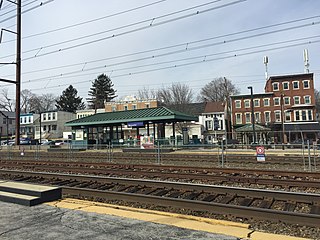
Downingtown station is a commuter and intercity passenger rail station located in the western suburbs of Philadelphia at West Lancaster Avenue & Stuart Avenue in Downingtown, Pennsylvania. It is served by most Amtrak Keystone Service and SEPTA Paoli/Thorndale Line trains. Amtrak's Pennsylvanian does not stop here. In 2017, the average total SEPTA weekday boardings at this station was 291, and the average total SEPTA weekday alightings was 312.

The Philadelphia to Harrisburg Main Line is a rail line owned and operated by Amtrak in the U.S. state of Pennsylvania. This is the only electrified Amtrak line in the United States outside of the main line of the Northeast Corridor. The line runs from Philadelphia, where it meets the Northeast Corridor at Zoo Junction at milepost 1.9, west to Harrisburg, where electrification ends. The Main Line is part of the longer Keystone Corridor, which continues west to Pittsburgh along the Norfolk Southern Railway's Pittsburgh Line. This section is sometimes referred to as "Keystone East" and is part of Amtrak's Keystone Service.

Amtrak's 25 Hz traction power system is a traction power network for the southern portion of the Northeast Corridor (NEC), the Keystone Corridor, and several branch lines between New York City and Washington D.C. The system was constructed by the Pennsylvania Railroad between 1915 and 1938 before the North American power transmission grid was fully established. This is the reason the system uses 25 Hz, as opposed to 60 Hz, which is the standard frequency for power transmission in North America. The system is also known as the Southend Electrification, in contrast to Amtrak's 60 Hz traction power system that runs between Boston and New Haven, which is known as the Northend Electrification system.
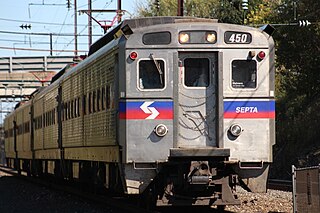
The Paoli/Thorndale Line, commonly known as the Main Line, is a SEPTA Regional Rail service running from Center City Philadelphia through Montgomery County and Delaware County to Thorndale in Chester County. It operates along the far eastern leg of Amtrak's Philadelphia to Harrisburg Main Line, which in turn was once the Main Line of the Pennsylvania Railroad and is now part of the Keystone Corridor, a federally-designated high-speed rail corridor.



